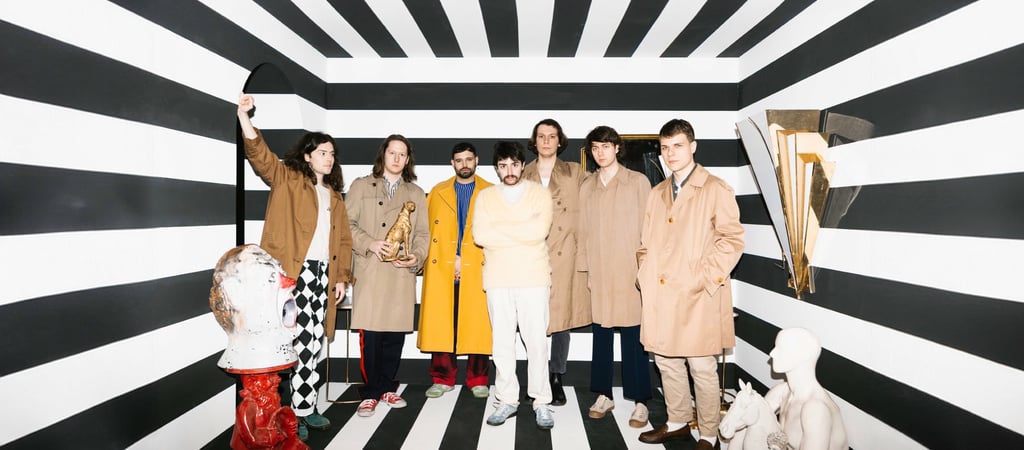Carson Coma
An unconventional blend of humor, introspection, and retro flair, Carson Coma is redefining what it means to be a rock band in 21st-century Hungary.
The Birth of Carson Coma: From Rebellion to Recognition
The origin story of Carson Coma is as unorthodox as the sound they’ve cultivated—part satire, part sincerity, all energy. Formed in Budapest in 2018, the band exploded onto the Hungarian music scene with an audacious blend of retro aesthetic, ironic lyrics, and an infectious stage presence. Comprised of six members—Fekete Giorgio, Bóna Benedek, Héra Barnabás, Kádár Bence, Jobbágy Bence, and Fekete László—Carson Coma did not emerge quietly. Rather, they arrived with a crash of tambourines, jangling guitars, and lyrics that oscillated between the deeply personal and the delightfully absurd. What made them instantly stand out was their refusal to fit into any established genre. Their music simultaneously echoed the British invasion, American 60s pop-rock, and modern indie sensibilities, all refracted through a distinctly Hungarian lens.
In a country where political overtones often color cultural expression, Carson Coma dared to offer something refreshingly offbeat. Their early performances were deliberately theatrical—filled with self-aware humor, surreal imagery, and a palpable sense of fun. Yet beneath the glitzy vintage costumes and winks to the audience was a serious commitment to musicianship, social commentary, and emotional complexity. By parodying and paying tribute to multiple eras at once, Carson Coma signaled a deeper artistic mission: to reimagine the boundaries of Hungarian pop music. Their name, which sounds like a Hollywood character and a pharmaceutical condition rolled into one, embodies the band’s playful, postmodern identity.
Though they initially drew comparisons to other European indie groups, their identity quickly solidified into something wholly their own. What began as a quirky student project rapidly morphed into a national sensation, with sold-out concerts, a rapidly growing online fan base, and a reputation for combining clever wordplay with an emotional authenticity that resonated with younger generations. At a time when Hungary’s cultural landscape was often divided between traditionalism and political polarization, Carson Coma offered a third way—creative, inclusive, and irreverently intelligent.
The Sound of Carson Coma: Vintage Soul with a Post-Internet Pulse
Musically, Carson Coma defies simple categorization. Their sonic palette is broad, adventurous, and always evolving. At first glance, the most apparent influences are the harmonic structures and instrumentation of the 1960s—shimmering electric guitars, organs, and tight vocal harmonies that call to mind The Beatles or The Kinks. Yet beneath the nostalgic surface lies a rhythm section that pulses with modern urgency, melodic lines laced with irony, and arrangements that flirt with everything from funk to punk to psychedelia. This mixture gives Carson Coma a time-warping sound, where past and present are constantly colliding in playful, poignant ways.
One of the band’s defining characteristics is their masterful use of linguistic duality. Singing primarily in Hungarian but occasionally incorporating English phrases, Carson Coma leverages language as both a cultural marker and a tool for satire. Their lyrics often contain layers of meaning, switching between romantic yearning, existential angst, and biting social observation. What makes this strategy effective is not just the cleverness of the writing, but the sincerity that underpins it. Even when they're poking fun at modern life, there is no cynicism—only curiosity and compassion wrapped in ironic distance.
Instrumentally, Carson Coma thrives on collaboration. Each member brings a different musical sensibility, and the result is a cohesive sound that still feels open-ended. Their tracks are filled with unexpected turns—a funky bass solo, a jazzy interlude, a sudden vocal harmony lifted from baroque pop. This unpredictability is part of their charm, making every song feel like an unfolding narrative, both familiar and surprising. At times, their music leans heavily into groove and rhythm, inviting dance and movement. At others, it becomes introspective and minimalist, creating space for reflection.
Despite their often humorous or ironic presentation, the band has increasingly shown a willingness to explore serious emotional territory. Themes such as alienation, love in the digital age, personal identity, and social anxiety appear frequently in their lyrics. But rather than falling into melancholy or despair, Carson Coma approaches these subjects with a sense of resilience and absurdist joy. In this way, their music becomes a refuge and a rebellion—an anthem for those who feel out of sync with the world around them but still want to dance through it.
Albums as Identity: A Chronicle of Growth and Experimentation
Over the years, Carson Coma’s discography has become a living document of their artistic evolution—a journey from playful newcomers to genre-defying innovators. Each album acts not only as a musical milestone but also as a cultural snapshot, capturing the mood of Hungary’s shifting youth landscape through witty lyricism and sonic experimentation. Their first full-length release, "Corduroy Club" (2019), was a vibrant homage to 60s garage rock and beat music, infused with a knowing wink and undeniable charm. Its tracks—playful, sunny, and brimming with youthful confidence—quickly captured the attention of the Hungarian indie scene. While heavily rooted in nostalgia, the album revealed Carson Coma's knack for reinventing familiar sounds with contemporary sensibilities, injecting retro aesthetics with a postmodern twist.
With the release of their second album, "Lesz, ami lesz" (2020), the band displayed significant growth in both tone and technique. Here, they ventured into more introspective territory, offering songs that reflected on uncertainty, youth in limbo, and the pressures of modern life. The album was created during a turbulent period—marked by the COVID-19 pandemic—and its themes of isolation, adaptability, and ironic hope struck a chord with audiences. Tracks such as "Pók" and "Kék Hullám Kemping" became instant anthems, blending humor with subtle melancholy. The production was tighter, the instrumentation more varied, and the confidence in songwriting more palpable.
Their third album, "Digitális / Analóg" (2022), marked a decisive step forward in both sound and structure. It showcased a more complex synthesis of influences—from funk and punk to synth-pop and folk—demonstrating that Carson Coma had fully embraced their eclectic identity. This dualistic album explored themes of digital alienation, nostalgia for analog simplicity, and the search for authenticity in a world saturated with performance. The title itself spoke to the dual nature of their sound: part nostalgic reverence, part digital-era critique. The band seemed fully aware of the contradictions inherent in their artistic identity, and rather than resolving them, they chose to celebrate the friction.
Each album not only diversified their fanbase but also expanded the boundaries of what Hungarian popular music could sound like. Where most local bands opted for straightforward genre adherence, Carson Coma thrived in the interstices—between irony and sincerity, past and future, mainstream appeal and underground quirk. This refusal to be pigeonholed is evident in their evolving production choices, increasingly layered arrangements, and growing thematic ambition. Their albums are not just collections of songs—they are cohesive aesthetic statements, filled with recurring motifs, experimental textures, and emotional narratives.
Through their discography, Carson Coma has mapped out a universe that is always shifting but unmistakably theirs. Each album opens a new chapter, offering listeners an ever-evolving soundscape that continues to surprise and seduce. In a scene often dominated by repetition and formula, their output feels like a breath of fresh air—intelligent, ironic, and deeply felt.
Where to Watch and Listen
Carson Coma’s music is remarkably accessible, available across major streaming platforms and digital stores. Their presence on Spotify, Apple Music, and YouTube has allowed their audience to grow well beyond Hungary’s borders. While their lyrics are often rooted in the Hungarian language, the musicality, aesthetic, and emotional resonance of their tracks transcend linguistic boundaries, making them increasingly popular among international listeners curious about Eastern Europe’s indie scene. Their Spotify profile regularly features curated playlists, live sessions, and remastered versions of older hits, offering a comprehensive listening experience for both newcomers and long-time fans.
YouTube has also been a pivotal platform for the band. Their music videos, often as quirky and carefully composed as their songs, blend humor with visual art, extending the band’s signature aesthetic into cinematic territory. Videos like "Táncórán" or "Hobbihajótörött" are filled with retro styling, surreal elements, and subtle nods to Hungarian cultural references. These videos have garnered hundreds of thousands of views, helping Carson Coma build a robust and visually cohesive brand that mirrors their sonic identity.
For those seeking a live music experience, Carson Coma regularly performs at festivals, concert halls, and clubs throughout Hungary and neighboring countries. Their presence at major festivals such as Sziget, Fishing on Orfű, and Strand Festival has cemented their status as one of Hungary’s top live acts. Their shows are not only musical events but immersive experiences that blend theater, audience interaction, and pure joy. Even fans who discover them online often cite their live performance energy as the moment they “truly got it.” Carson Coma’s ability to translate studio precision into electrifying stage presence is one of the reasons their following continues to expand.
Official Links
These platforms offer a complete view into Carson Coma’s sonic and visual world, from albums and music videos to live performances and personal updates.
Website: www.carsoncoma.com
Instagram: instagram.com/carsoncoma
Facebook: facebook.com/carsoncoma
YouTube: youtube.com/@carsoncoma
Spotify: open.spotify.com/artist/0yMnwb0yGQFKnEXV1N0e7T
Apple Music: music.apple.com/us/artist/carson-coma


Performance as Ritual: The Power of Presence and Playfulness
The live performances of Carson Coma are central to understanding their impact. Much more than concerts, their shows are immersive experiences—part theater, part communal celebration. The band is known for its charismatic stage presence, blending flamboyant costumes, witty banter, and spontaneous crowd interaction. These performances feel both curated and chaotic, balancing tight musical precision with a looseness that allows for improvisation and surprise. For their audience, this unpredictability is exhilarating; it means no two Carson Coma shows are ever the same.
At the heart of these performances is a deep connection between the band and their fans. Rather than performing from a distance, the band collapses the barrier between stage and crowd, often inviting participation through sing-alongs, in-jokes, and call-and-response moments. This sense of community is a defining aspect of their identity. In a time when many young people feel politically disillusioned or socially fragmented, Carson Coma creates a space for belonging, built not on ideology but on shared experience and emotional resonance.
Another fascinating element of their stagecraft is the visual language they employ. From retro television sets and surreal backdrops to ironic merchandise and projected lyrics, Carson Coma weaves a narrative that extends beyond sound. They embrace the aesthetics of past decades—often filtered through a millennial and Gen Z lens of post-ironic humor and digital-age commentary. The result is a kind of visual-musical pastiche, where everything from 80s synth-pop tropes to modern meme culture might find its place.
Despite the often light-hearted mood, the band never treats performance as trivial. Every detail, from lighting cues to transitions between songs, is part of a larger aesthetic choreography. Even the moments of chaos are intentional, strategically used to disarm and draw in the audience. This attention to detail reflects their professionalism and vision, elevating them beyond the realm of indie quirkiness into something far more substantial: a multi-dimensional artistic phenomenon.
In these performances, Carson Coma does more than entertain—they create a temporary utopia, where humor, authenticity, and sound coalesce into a singular moment of joy. This is where their cultural significance becomes most apparent. In the space of an hour, they can turn irony into insight, nostalgia into novelty, and chaos into catharsis. Through this alchemy, they have built a loyal fan base that sees them not just as musicians, but as cultural mirrors for a restless generation.






Awarded with the Highest Distinction
Carson Coma was selected for the Excellence Award for their unique ability to bridge generations, genres, and emotions with intelligence, wit, and originality. Their music is a testament to the power of artistic freedom, cultural commentary, and the enduring joy of innovation. They are not just a band—they are a movement worth hearing, seeing, and celebrating.







